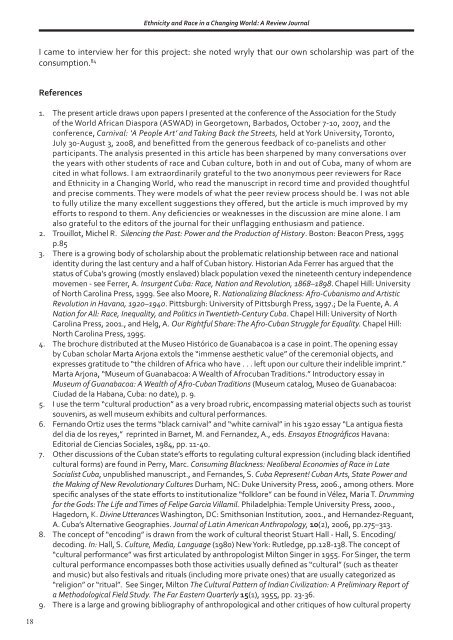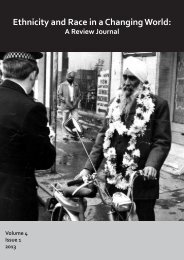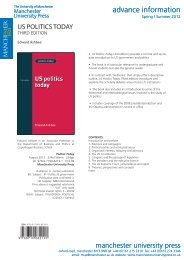<strong>Ethnicity</strong> <strong>and</strong> <strong>Race</strong> <strong>in</strong> a Chang<strong>in</strong>g <strong>World</strong>: A Review JournalI came to <strong>in</strong>terview her for this project: she noted wryly that our own scholarship was part of theconsumption. 84References1. The present article draws upon papers I presented at the conference of the Association for the Studyof the <strong>World</strong> African Diaspora (ASWAD) <strong>in</strong> Georgetown, Barbados, October 7-10, 2007, <strong>and</strong> theconference, Carnival: ‘A People Art’ <strong>and</strong> Tak<strong>in</strong>g Back the Streets, held at York University, Toronto,July 30-August 3, 2008, <strong>and</strong> benefitted from the generous feedback of co-panelists <strong>and</strong> otherparticipants. The analysis presented <strong>in</strong> this article has been sharpened by many conversations overthe years with other students of race <strong>and</strong> Cuban culture, both <strong>in</strong> <strong>and</strong> out of Cuba, many of whom arecited <strong>in</strong> what follows. I am extraord<strong>in</strong>arily grateful to the two anonymous peer reviewers for <strong>Race</strong><strong>and</strong> <strong>Ethnicity</strong> <strong>in</strong> a Chang<strong>in</strong>g <strong>World</strong>, who read the manuscript <strong>in</strong> record time <strong>and</strong> provided thoughtful<strong>and</strong> precise comments. They were models of what the peer review process should be. I was not ableto fully utilize the many excellent suggestions they offered, but the article is much improved by myefforts to respond to them. Any deficiencies or weaknesses <strong>in</strong> the discussion are m<strong>in</strong>e alone. I amalso grateful to the editors of the journal for their unflagg<strong>in</strong>g enthusiasm <strong>and</strong> patience.2. Trouillot, Michel R. Silenc<strong>in</strong>g the Past: Power <strong>and</strong> the Production of History. Boston: Beacon Press, 1995p.853. There is a grow<strong>in</strong>g body of scholarship about the problematic relationship between race <strong>and</strong> nationalidentity dur<strong>in</strong>g the last century <strong>and</strong> a half of Cuban history. Historian Ada Ferrer has argued that thestatus of Cuba’s grow<strong>in</strong>g (mostly enslaved) black population vexed the n<strong>in</strong>eteenth century <strong>in</strong>dependencemovemen - see Ferrer, A. Insurgent Cuba: <strong>Race</strong>, Nation <strong>and</strong> Revolution, 1868–1898. Chapel Hill: Universityof North Carol<strong>in</strong>a Press, 1999. See also Moore, R. Nationaliz<strong>in</strong>g Blackness: Afro-Cubanismo <strong>and</strong> ArtisticRevolution <strong>in</strong> Havana, 1920–1940. Pittsburgh: University of Pittsburgh Press, 1997.; De la Fuente, A. ANation for All: <strong>Race</strong>, Inequality, <strong>and</strong> Politics <strong>in</strong> Twentieth-Century Cuba. Chapel Hill: University of NorthCarol<strong>in</strong>a Press, 2001., <strong>and</strong> Helg, A. Our Rightful Share: The Afro-Cuban Struggle for Equality. Chapel Hill:North Carol<strong>in</strong>a Press, 1995.4. The brochure distributed at the Museo Histórico de Guanabacoa is a case <strong>in</strong> po<strong>in</strong>t. The open<strong>in</strong>g essayby Cuban scholar Marta Arjona extols the “immense aesthetic value” of the ceremonial objects, <strong>and</strong>expresses gratitude to “the children of Africa who have . . . left upon our culture their <strong>in</strong>delible impr<strong>in</strong>t.”Marta Arjona, “Museum of Guanabacoa: A Wealth of Afrocuban Traditions.” Introductory essay <strong>in</strong>Museum of Guanabacoa: A Wealth of Afro-Cuban Traditions (Museum catalog, Museo de Guanabacoa:Ciudad de la Habana, Cuba: no date), p. 9.5. I use the term “cultural production” as a very broad rubric, encompass<strong>in</strong>g material objects such as touristsouvenirs, as well museum exhibits <strong>and</strong> cultural performances.6. Fern<strong>and</strong>o Ortiz uses the terms “black carnival” <strong>and</strong> “white carnival” <strong>in</strong> his 1920 essay “La antigua fiestadel dia de los reyes,” repr<strong>in</strong>ted <strong>in</strong> Barnet, M. <strong>and</strong> Fern<strong>and</strong>ez, A., eds. Ensayos Etnográficos Havana:Editorial de Ciencias Sociales, 1984, pp. 11-40.7. Other discussions of the Cuban state’s efforts to regulat<strong>in</strong>g cultural expression (<strong>in</strong>clud<strong>in</strong>g black identifiedcultural forms) are found <strong>in</strong> Perry, Marc. Consum<strong>in</strong>g Blackness: Neoliberal Economies of <strong>Race</strong> <strong>in</strong> LateSocialist Cuba, unpublished manuscript., <strong>and</strong> Fern<strong>and</strong>es, S. Cuba Represent! Cuban Arts, State Power <strong>and</strong>the Mak<strong>in</strong>g of New Revolutionary Cultures Durham, NC: Duke University Press, 2006., among others. Morespecific analyses of the state efforts to <strong>in</strong>stitutionalize “folklore” can be found <strong>in</strong> Vélez, Maria T. Drumm<strong>in</strong>gfor the Gods: The Life <strong>and</strong> Times of Felipe Garcia Villamil. Philadelphia: Temple University Press, 2000.,Hagedorn, K. Div<strong>in</strong>e Utterances Wash<strong>in</strong>gton, DC: Smithsonian Institution, 2001., <strong>and</strong> Hern<strong>and</strong>ez-Reguant,A. Cuba’s Alternative Geographies. Journal of Lat<strong>in</strong> American Anthropology, 10(2), 2006, pp.275–313.8. The concept of “encod<strong>in</strong>g” is drawn from the work of cultural theorist Stuart Hall - Hall, S. Encod<strong>in</strong>g/decod<strong>in</strong>g. In: Hall, S. Culture, Media, Language (1980) New York: Rutledge, pp.128-138. The concept of“cultural performance” was first articulated by anthropologist Milton S<strong>in</strong>ger <strong>in</strong> 1955. For S<strong>in</strong>ger, the termcultural performance encompasses both those activities usually def<strong>in</strong>ed as “cultural” (such as theater<strong>and</strong> music) but also festivals <strong>and</strong> rituals (<strong>in</strong>clud<strong>in</strong>g more private ones) that are usually categorized as“religion” or “ritual”. See S<strong>in</strong>ger, Milton The Cultural Pattern of Indian Civilization: A Prelim<strong>in</strong>ary Report ofa Methodological Field Study. The Far Eastern Quarterly 15(1), 1955, pp. 23-36.9. There is a large <strong>and</strong> grow<strong>in</strong>g bibliography of anthropological <strong>and</strong> other critiques of how cultural property18
<strong>Ethnicity</strong> <strong>and</strong> <strong>Race</strong> <strong>in</strong> a Chang<strong>in</strong>g <strong>World</strong>: A Review Journal(<strong>in</strong>clud<strong>in</strong>g artifacts, performance <strong>and</strong> sites) <strong>and</strong> cultural identities are shaped by tourism <strong>and</strong> otherneoliberal approaches. A good start<strong>in</strong>g po<strong>in</strong>t is Barbara Kirshenblatt-Gimblett’s essay, “Objects ofEthnography” - see Kirshenblatt-Gimblett, B. Objects of Ethnography. In: Karp, I <strong>and</strong> Lav<strong>in</strong>e, S. eds.Exhibit<strong>in</strong>g Cultures: The Politics <strong>and</strong> Poetics of Museum Displays. Wash<strong>in</strong>gton: Smithsonian Institution,1998, pp. 386-443. Kirshenblatt-Gimblett further develops some of these arguments <strong>in</strong> her bookDest<strong>in</strong>ation Culture: Tourism, Museums <strong>and</strong> Heritage - see Kirshenblatt-Gimblett, B. Dest<strong>in</strong>ation Culture:Tourism, Museums <strong>and</strong> Heritage Berkeley: University of California Press, 1998. Other useful works <strong>in</strong>cludeBrown, Michael F. Who Owns Native Culture?, Cambridge, MA: Harvard University Press, 2004. AudraSimpson’s forthcom<strong>in</strong>g work on the Kahenwake Mohawk <strong>and</strong> Jessica Cattel<strong>in</strong>o’s study of the FloridaSem<strong>in</strong>ole explore the neoliberal treatment of <strong>in</strong>digenous identities <strong>in</strong> North America. See Simpson, A.To the Reserve <strong>and</strong> Back Aga<strong>in</strong>: Kahnawake Mohawk Narratives of Self, Home <strong>and</strong> Nation. Durham : DukeUniversity Press, forthcom<strong>in</strong>g, <strong>and</strong> Cattel<strong>in</strong>o, J. Cas<strong>in</strong>o Roots: The Cultural Production of Twentieth-Century Sem<strong>in</strong>ole Economic Development. In: Hosmer, B. <strong>and</strong> O’Neill, C., eds. Native Pathways:Economic Development <strong>and</strong> American Indian Culture <strong>in</strong> the Twentieth Century. Boulder: University ofColorado Press, 2004, pp. 66-90. As Quetzil Castañeda <strong>and</strong> other scholars have argued, anthropology(<strong>and</strong> especially archaeology) is often complicit <strong>in</strong> the touristic reprsentation <strong>and</strong> consumption ofracialized identities. See, among other works, Castañeda, Q. In the Museum of Maya Culture: Tour<strong>in</strong>gChichen Itza. M<strong>in</strong>neapolis: University of M<strong>in</strong>nesota Press, 1996.10. In recent years, scholars both <strong>in</strong>side <strong>and</strong> outside Cuba have begun to challenge (<strong>and</strong> break) the officialsilences around race. A signal publication was the 1990 publication of Cuban scholar Tomas Fern<strong>and</strong>ezRoba<strong>in</strong>a’s book El Negro en Cuba 1902-1958 - see Fern<strong>and</strong>ez Roba, T. El Negro en Cuba 1902-1958.Havana: Edition de Ciencias Sociales. 1900. - but as the title makes clear, Roba<strong>in</strong>a’s analysis stops atthe eve of the revolution. S<strong>in</strong>ce the mid-1990s, several U.S.-based <strong>and</strong> other <strong>in</strong>ternational scholarshave explored racial dynamics after the 1959 revolution. Alej<strong>and</strong>ro de la Fuente’s A Nation For All (ref.3_<strong>in</strong>cludes several chapters on post-revolutionary Cuba, <strong>and</strong> race is a central theme <strong>in</strong> Rob<strong>in</strong> Moore’sMusic <strong>and</strong> Revolution: Cultural Change <strong>in</strong> Socialist Cuba - see Moore, R. Music <strong>and</strong> Revolution: CulturalChange <strong>in</strong> Socialist Cuba. Berkeley: University of California Press, 2006 - as does Nad<strong>in</strong>e Fern<strong>and</strong>ez’s bookRevolutioniz<strong>in</strong>g Romance: Interracial Couples <strong>in</strong> Contemporary Cuba - Fern<strong>and</strong>ez, N. Revolutioniz<strong>in</strong>gRomance: Interracial Couples <strong>in</strong> Contemporary Cuba. New Brunswick, NJ: Rutgers University Press, 2010.See also, among other sources: De la Fuente, A. The New Afro-Cuban Cultural Movement <strong>and</strong> the Debateon <strong>Race</strong> <strong>in</strong> Contemporary Cuba. Journal of Lat<strong>in</strong> American Studies. 40(November) 2008, pp.697-720;Fernández, N. The Chang<strong>in</strong>g Discourse of <strong>Race</strong> <strong>in</strong> Contemporary Cuba. Qualitative Studies <strong>in</strong> Education.14(2), 2001, pp.117–132; <strong>and</strong> Hernández-Reguant, A. Cuba’s Alternative Geographies (ref.7). With<strong>in</strong> Cuba,several researchers at the Centro de Antropología conducted a long-term study of race - the publicationsthey have produced <strong>in</strong>clude Esp<strong>in</strong>a Prieto, R. <strong>and</strong> Rodriguez Ruiz, P. Raza y desigualdad en la Cubaactual (<strong>Race</strong> <strong>and</strong> <strong>in</strong>equality <strong>in</strong> Cuba today). Temas, 45(Jan-March), 2006, pp. 44-54. Roberto Zurbano, anessayist <strong>and</strong> vice-president of the National Union of Cuban Artists <strong>and</strong> Writers (UNEAC), has publishedseveral pieces on race, <strong>in</strong>clud<strong>in</strong>g Zurbano, R. El triángulo <strong>in</strong>visible del siglo XX cubano: raza, literaturay nación (the <strong>in</strong>visible triangle of the Cuban 20th century: race, literature <strong>and</strong> nation). Temas 46(April-June), 2006, pp. 111-123.11. For background on Cuba’s “touristic turn”, <strong>and</strong> some of the social <strong>and</strong> cultural implications, see Schwartz,R. Pleasure Isl<strong>and</strong>: Tourism <strong>and</strong> Temptation <strong>in</strong> Cuba, L<strong>in</strong>coln, Nebraska: University of Nebraska Press,1997. Both Cuban government sources <strong>and</strong> external observers have tabulated the ups <strong>and</strong> downs ofCuba’s tourist sector over the past decade, with foreign (especially U.S.-based) sources often mak<strong>in</strong>gdire predictions based on periodic downturns. Over the 1990s tourism grew to around 2 million visitorsannually, with tourism revenues account<strong>in</strong>g for a substantial share of the national economy.12. There was a noticeable slump <strong>in</strong> <strong>in</strong>ternational tourism overall <strong>and</strong> tourism to Cuba <strong>in</strong> particular follow<strong>in</strong>gthe September 11, 2001 attack on the <strong>World</strong> Trade Center but tourism appears to have recoveredsomewhat. Accord<strong>in</strong>g to Cuban government sources, there were 2.3 million visitors <strong>in</strong> 2008 - see: Grogg,P. Big Hopes for Tourism Industry. [Onl<strong>in</strong>e] 2009 (Retrieved July 12, 2009) Interpress Service (IPS) Urlhttp: http://ipsnews.net/news.asp?idnews=4621813. The Cuban government had established farmers’ markets <strong>in</strong> the early 1980s but they were closed after afew years.14. See Henken, T. Condemned to Informality: Cuba’s Experiments with Self-employment Dur<strong>in</strong>g the SpecialPeriod, Ph.D. dissertation, Stone Center, for Lat<strong>in</strong> American Studies, Tulane University; Sacchetti,E. Experiment<strong>in</strong>g with Change: An Anthropological Perspective on Cuban Micro-Enterprise. Cuba In19






